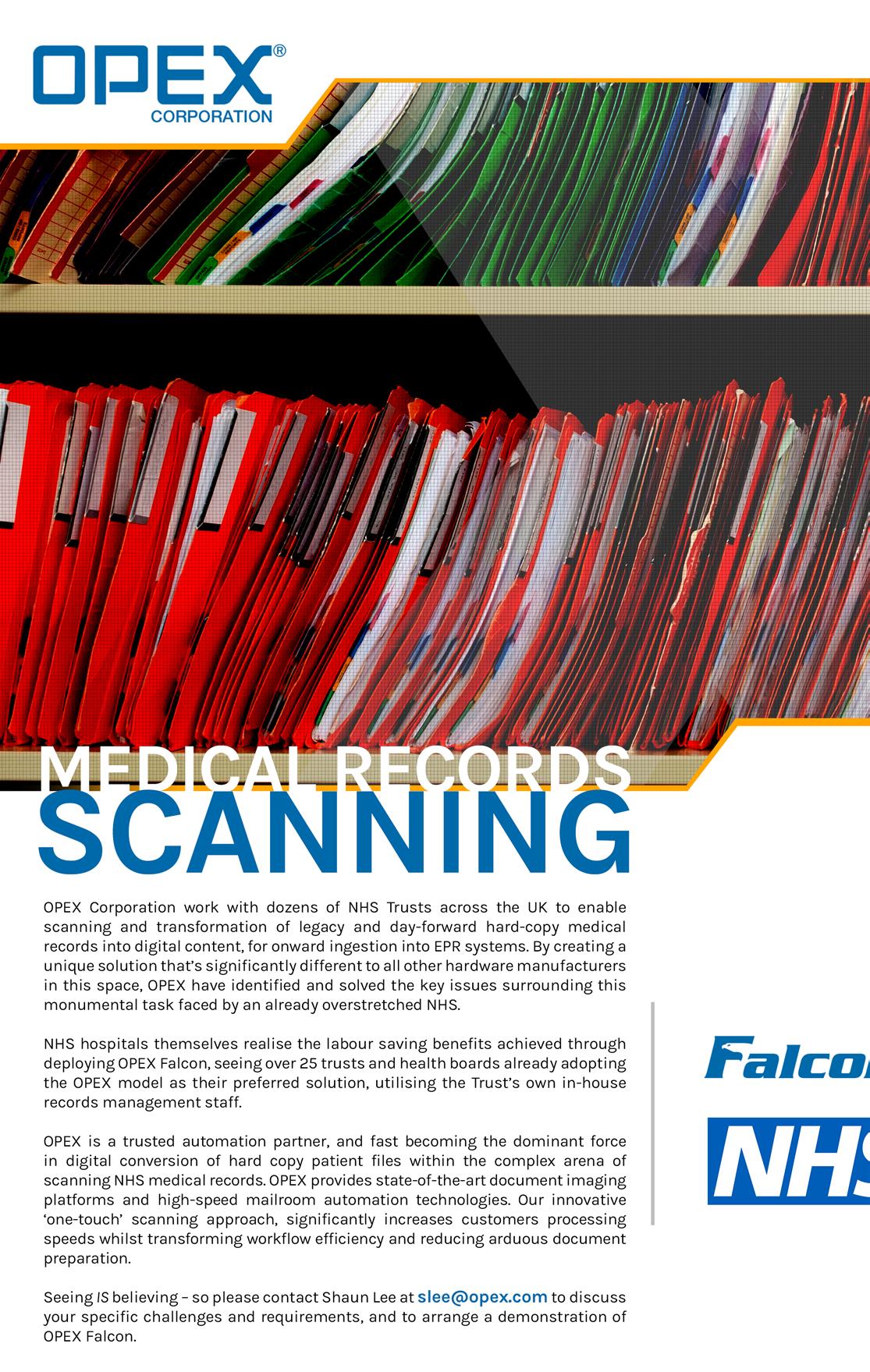
34 minute read
Fire safety
from Health Business 20.1
by PSI Media
Building a fire safety culture in health facilities
Dr David Gold and Neil Vincer, from IOSH, discuss how organisations can ensure that a sustainable workplace fire safety culture is incorporated to all staff in a hospital setting
Health care workers play a vital role in today’s society, especially considering the ageing populations in many countries that need or will need care either in health care facilities or at home. All members of the health care profession should continually work in a safe and healthy environment carrying out practices that do not put them at risk of injury or ill health. A previous article in this journal examined several of the risks health care professionals face and described measure to eliminate or mitigate those risks. Occupational safety and health promotes the concept of a safety culture. A safety culture exists when workers throughout an organisation not only continually look out for their personal safety and health, but also look out for the safety and health of others including their co-workers. The concept of a safety culture embraces positive values, including attitudes and knowledge. Professionals working in the health care field, by the nature of their profession and their duty of care, extend the safety culture to protect their patients, some of whom cannot look after themselves, especially during an emergency situation. The American Bureau of Shipping (ABS) proposes eight categories of leading indicators of a safety culture. The following are leading indicators, adapted from the ABS publication, that fall under the eight categories: Communication about fire safety The organisation: develops means of communication including the provision of information sheets, newsletters, and toolbox talks, in local languages regarding incidents and lessons learned about fire safety; includes adequate fire safety information as part of new employee induction providing; and shares with employees, contractors and visitors policies, goals, directives and standards addressing fire safety. Empowerment
The organisation: involves all
workers and contractors in fire safety; and develops and promotes for all workers means to bring fire
safety to their home. Feedback The organisation: documents the presence and use of a fire safety worker feedback mechanism; and ensures that information about fire-related risks, incidents, and near misses are communicated to workers. E A safety culture exists when workers not only continually look out for their personal safety and health, but also look out for the safety and health of others
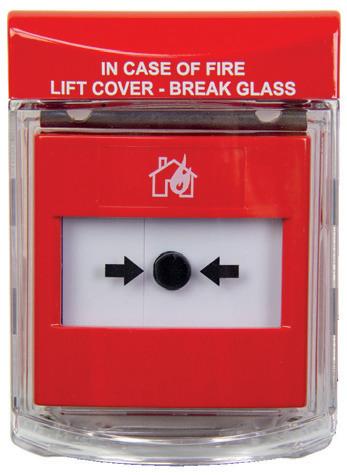
False fire alarms have risen by 20% in three years at NHS Trusts across England *


Reduce False Fire Alarms with STI’s range of protective covers which protect a wide range of electrical switches and call points.
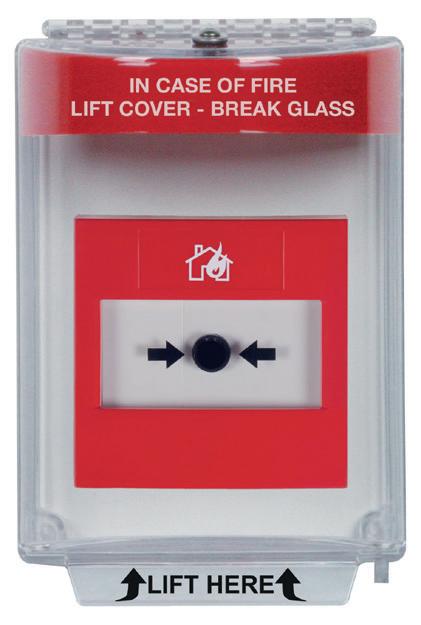
Management of health care facilities has an upstream responsibility, a duty of care, to ensure all aspects of safety, health and fire safety are addressed and reinforced for health care professionals, patients, visitors, contractors and others visiting the facility
Mutual trust The organisation establishes a fair system for fire-related incident investigation.
Problem identification The organisation: puts in place and maintains a policy mandating fire safety procedures and instructions with specific information on job-specific fire safety; establishes and maintains a policy and procedures for reporting unsafe fire-related conditions and actions; and ensures that fire safetyrelated checklists are regularly updated.
Promotion of safety The organisation: has fire safety-related safety goals and objectives; has a procedure making all fire-related incident investigation findings available to workers; and requires senior management attend meetings related to fire safety.
Responsiveness The organisation: regularly implements fire training programmes for different category of emergencies; puts in place and maintains an organisational-wide effort to continually promote fire safety awareness; and puts in place and maintains training programmes for assessing risks related to fire.
Safety awareness The organisation provides fire safety awareness training and puts in place procedures to document the training.
Management of health care facilities, whether public or private, has an upstream responsibility, a duty of care, to ensure all aspects of safety, health and fire safety are addressed and reinforced for health care professionals, patients, visitors, contractors and others visiting the facility. For example, bedding is common in a health care environment, and is a source of fuel. Oxygen is ever present, and may be more concentrated around some patients, but the risk of fire is minimal if there are no sources of heat. Therefore bedding, either laundered or soiled, should always be stored away from sources of heat.
In health care facilities areas, such as laundries, laboratories, pharmacies, heating plants and waste disposal areas may have elevated fire risks as the potential for the combination of fuel and heath may be elevated. Even health care facilities that may be designated smoke free campuses may be at risk from ignition from open flames such as cigarette lighters, matches or discarded cigarettes due to a perceived urgent need to smoke by staff, patients, visitors or contractors who will try to find an area where they can smoke unobserved. Health care facilities may also have flammable and combustible liquids or gases in different areas of the facility. Laboratories, operating theatres and casualty, maintenance areas, pharmacies as well as supply areas may stock certain products that when exposed to heat may ignite. Also shipping and receiving areas may have combustible waste that needs to be disposed of. The basic philosophy which needs to be vigilantly followed is to keep heat, fuel and oxygen apart. Fire protection Fire protection in health care facilities includes what is needed to protect the patient, workers, visitors and others from the danger of fire. This includes, but is not limited to: the preparation and keeping upto-date a number of required and essential documents; systems to detect smoke or heat; automatic fire suppression systems such as automatic sprinkler systems; mechanisms to notify the local emergency services that an alarm has been activated; systems to notify staff, patients, visitors and others to evacuate; a system of designated primary and secondary emergency escape routes from all areas of the building; designated external emergency assembly areas; a system to account for evacuated patients, staff, visitors and others; mechanisms to provide continuity of care during an evacuation including agreements with other facilities to provide shelter as necessary; staff training on evacuating patients; regular drills and exercises involving the local emergency services; fire related doors including selfclosing mechanisms to limit the spread of smoke and fire by-products; stairways that are protected from smoke; and a compilation of safety data sheets that is readily available and describes the properties of hazardous substances used in the facility. Although the 14 above-mentioned points are examples of essential fire protection elements, it would take more than a journal article to provide detailed information on each one. We would, however, like to call your attention to a few.
Evacuation It is essential that there are designated emergency escape routes from all areas of the facility to a place of safety. These routes need to be clearly marked, continually unobstructed, well lit, and unlocked. E
Fire prevention What managers need to consider about fire prevention is keeping apart the three elements that when combined in the right proportions can create fire or explosions. The three elements are heat (also known as source of ignition), fuel (also known as combustible or flammable materials in solid, liquid or gas form) and oxygen (bearing in mind the level of oxygen we need to breathe is the same level that supports fire).
An essential element of fire risk assessment, if properly done by an appropriately trained competent person identifies, assesses and proposes control measures to either eliminate or control the risk and follows up where and when these elements, in combination, may increase the risk of fire.







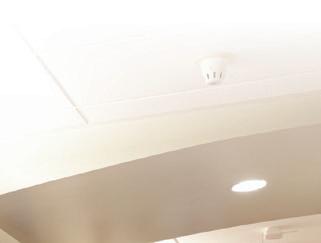

TOUCHSAFE ® PRO WIRELESS NURSE CALL SYSTEM FUTURE PROOF IP READY TECHNOLOGY
Request Assistance





Automated Triage




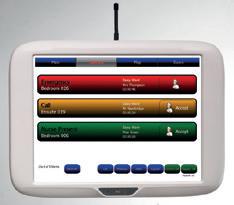
Follow Me Lights




Mobile Messaging
Call: 0800 052 3616 Web: www.aidcall.co.uk Contact us now for a FREE quotation and product demonstration...

Audit Trail

the (US) Occupational Safety and Health Administration (OSHA) an Emergency Action Plan must contain the following elements: a description of types of emergencies that could occur to the facility; means of reporting fires and other emergencies; levels of emergencies and criteria for escalation; evacuation procedures and emergency escape route assignments; procedures for staff who remain in order to assist patients and others or shut down critical functions before they evacuate; procedures for accounting for all patients, employees and visitors after an emergency evacuation has been completed; rescue and medical duties for employees performing them; names or job titles of persons who can be contacted; agreements with emergency services; agreements with other facilities to accept evacuated patients; and timing for the regular review of the emergency action plan.
In consultation with the local fire service, the emergency action plan may call for a phased evacuation, not evacuating all patients and staff at once. In some facilities there are designated areas of refuge (with specific engineering criteria) where evacuees wait for assistance from the emergency services.
An emergency escape route may be part of a normal passageway. Often times the secondary emergency escape routes may be passageways and doors that are not in constant use. In some locations, during the winter season, the doors leading outside may be obstructed by snow. It is essential that all designated escape routes are regularly inspected by a designated person and are continually unobstructed.
Evacuation in a health care facility includes both ambulatory and non-ambulatory patients, although during a fire emergency, ambulatory patients may become non-ambulatory due to fear or stress. Moving non-ambulatory patients in beds may not be feasible. In a number of facilities an evacuation sheet is used. It is essential, however, that health care facility staff are trained in how to evacuate a patient using a drag sheet or other evacuation mechanisms that the facility uses.
Accountability Patients, staff, visitors and others need to be accounted for once outside of the building. A means of accounting for who is missing needs to be set up and described in the emergency action plan. There also needs to be a means of rapidly informing the responding emergency service who is not accounted for and where and when they were last seen. This will greatly influence the search and rescue strategy of the emergency service.
Planning Planning for fires and other emergencies needs to be done in advance. As essential documents are drafted, proposed measures need to be tested and revisited as necessary. When new procedures are designed and implemented and new equipment, materials and products are brought into the facility, plans need to be re-examined and adjusted as necessary. Desk top exercises and evacuation drills are essential means for determining whether plans are effective. Key to successful emergency planning is the training and education of all staff including hands-on practical training so that their respective roles in a fire and evacuation become second nature. It is also a good practice to provide all staff, during induction, a thorough briefing on fire safety and regular refresher training.
Visitors, contractors and others should also be provided information about fire safety when they work in or visit the facility.
Essential documents This article suggest three essential documents that should be continually reviewed and updated as necessary. The three documents are the fire risk assessment, the emergency action plan and the fire prevention plan. All documents should be drafted in concert with the local emergency services and should be reviewed with these services before finalised.
The fire risk assessment According to the publication Fire Safety Risk Assessment: Health care premises and the (UK) Health and Safety Executive, there are five steps for carrying out a risk assessment: identify fire hazards; identify people at risk; evaluate, remove, reduce and protect from risk; record, plan, inform, instruct and train; and review. The Fire Safety Risk Assessment: Health care premises publication goes into further guidance of what needs to be considered on the following topics: fire risks and preventative measures; fire-detection and warning systems; firefighting equipment and facilities; escape routes and strategies; emergency escape lighting; signs and notices; recording, planning, informing; and instructing and training.
Strong consideration should also be given to who is carrying out the risk assessment for the facility. Criteria for the competencies of fire risk assessors can be found in the following document: https://www.london-fire. gov.uk/media/1106/guidance-choosinga-competent-fire-risk-assessor-2.pdf.
The emergency action plan An emergency action plan is based on a risk assessment, carried out by a competent risk assessor. Partially based on a document from The Fire Prevention Plan A number of organisations also publish a fire prevention plan. It is based on the fire risk assessment and includes a description of sources of fuel and sources of ignition at the facility that could cause or contribute to the spread of fire. The plan also describes alarm systems and fire extinguishing systems. The plan should also describe protection dealing with the detection, the outbreak and the spread of fire. Based on HSE guidance the plan should also provide clear instructions on eliminating or controlling sources of heat, diminish the amount of combustible or flammable materials. The plan should describe measures to: avoid or control sources of ignition; eliminate or minimise combustible or flammable materials; separate sources of heat from fuel; detect fires and raise the alarm; minimise the spread of fire, smoke, or bi-products of fire; and take action on discovering a fire or when a fire alarm is activated.
Even in the most up-to-date health care facility with the most modern fire safety equipment, fires can and do occur. It is essential that fires are prevented and that we do everything that is reasonably practicable to protect ourselves, workers, patients, visitors, contractors and others from the dangers of fire. Empowering the health care professional and other staff with information and training on preventing fires and procedures should a fire occur will help build a culture of fire safety in the organisation. A clearly demonstrated commitment by senior management has also been proven to further strengthen this culture.
Everyone needs to understand the risks of fire and the means to either eliminate the risk or mitigate it to an acceptable level. L
Dr David Gold, CFIOSH, is vice president of the Institution of Occupational Safety and Health (IOSH) and former chair of the IOSH Fire Risk Management Group. Neil Vincer, CMIOSH is the current chair.
EXPERT PANEL
PARKING
In our second Health Business Expert Panel on parking we are joined by representatives from Debt Recovery Plus, GroupNexus, WPS Parking and the British Parking Association to discuss the ongoing issues relating to hospital parking
Dave Smith, BPA

Stewart Clure, Debt Recovery Plus


Grahame Rose, GroupNexus
Dave leads the Public Affairs and Communications Team at the British Parking Association to promote, develop and maintain relationships with politicians, stakeholders and the media. Dave developed the BPA’s current communications strategy, to help raise the profile of the association with all key audiences including members, stakeholders, media and public. Stewart joined Debt Recovery Plus in 2015, having previously spent five years working in the private parking sector. Through his experience of working with clients on retail, commercial, NHS and various other sites, Stewart was able to bring his knowledge of the industry to DRP. Since graduating from Leeds University with a 2:1 in Maths, Stewart worked on the Barclays Graduate Scheme before ending up at Savills. Grahame joined CP Plus in 1995. Coming from a small business background his ‘hands on’, service orientated approach fitted in perfectly with the business outlook. He has been instrumental in the creation of GroupNexus, from a company that managed 28 sites when he joined to its current portfolio of over 1,200. Grahame is a Board Member of the BPA, regularly speaking at industry events. Simon Jarvis, WPS

Simon Jarvis is the UK Managing Director for WPS, a global leader in parking systems for over 25 years, with a long-held reputation for engineering excellence and providing the industry’s most reliable solutions. It is part of Dynniq, a dynamic, high-tech and innovative company with a comprehensive knowledge of managing mobility, parking and energy using advanced systems engineering.
At the start of December last year, data from the Press Association revealed that a third of hospitals in England put up car parking charges in the previous 12 months, with total income rising by 10 per cent. Freedom of information data from more than 140 NHS trusts showed that £254 million had been raised during 2018-19, an increase from £232 million the year before, with hourly charges varying between £4 and £1 for an hour.
As well as highlighting fee increases, the Press Association survey also indicated dissatisfaction with hospital parking charges, with the poll of more than 7,800 people finding that 86 per cent of respondents felt that parking added to the stress of their hospital visit.
Free hospital parking In the same month, the Queen’s Speech announced that hospital car parking charges would be removed for those in greatest need, benefiting thousands of patients up and down the country. Health Secretary Matt Hancock said that disabled people, frequent outpatient attenders, parents of sick children staying overnight and staff working night shifts will not have to pay for NHS car parking from April 2020. Furthermore, the government will also consider car parking
capacity across the country, and how improved technology will reduce burdens for hospitals and take away stress for visitors. It means that all 206 hospital trusts in England will be expected to provide free car parking to groups that may be frequent hospital visitors, or those disproportionately impacted by daily or hourly charges for parking. As before, any profits from remaining car parking charges must be reinvested into frontline care.
The British Parking Association is supporting the government in developing the proposals, reiterating their desire to help them devise and deliver a solution which helps to make
hospital parking better for everyone. The association’s Dave Smith says that, whilst he believes it is wrong that healthcare budgets should be used to provide parking facilities for those who choose to drive to hospital, the BPA also thinks there should be exceptions, particularly where there is no alternative and especially where long term or vulnerable patients are concerned.
That is a viewpoint shared by our panellists, with Stewart Clure saying that the move is a ‘much needed boost to hospital visitors’. However, the age-old argument remains, with the opinion of our experts all leaning towards there being no such thing as free parking. The NHS receives a steady revenue stream from their parking provisions which helps to support other NHS funded services. Without this income, says Clure, other services would inevitably have to be sacrificed. Grahame Rose agrees, stating that if there were no charges, the costs of car park maintenance, equipment and management would all have to be taken from the healthcare budget. There are numerous estimates but it’s sometimes quoted at £2 million/annum. Rose also highlights that, when it comes to free parking, people who use public transport or taxis don’t get their fares paid.
Aside from the cost argument, Simon Jarvis of WPS points to the environmental and demand issues. In all other forms of parking, charging forms part of a green transport plan which discourages people seeing cars as the default mode of transport. Indeed, WPS were recently criticised by the Green Party for helping a local authority customer to realise a free parking validation scheme to support local retailers because they believed it would encourage people to drive into town. Supply versus demand We all know that parking space availability is limited – if parking is free, it is likely that demand will increase which is likely to increase congestion and make finding a space far more difficult. How do we control this if parking becomes free to all or many? Using Scotland as an example, Jarvis claims that free hospital parking is attractive to shoppers and commuters, with cases documented of people leaving their cars in hospital car parks while they fly off on holiday! On the issue of demand, there is no denying that hospitals are always over-subscribed in terms of their parking capacity, and also worth noting that the NHS has more special requirements and considerations than most organisations offering car parking facilities. However, the problem of abuse by motorists that have no business at a hospital has largely been solved by the introduction of parking systems, whether this is barriers or enforcement via ANPR. Demand will always outweigh supply in terms of spaces, because hospital parking is not an unlimited resource and users are continuing to grow. Stewart Clure says that there are various ways to manage the The Queen’s Speech recently announced that hospital car parking charges will be removed for those in greatest need
staff usage and control dwell times and through close management and flexibility, issues and errors can be controlled.
Dave Smith highlights the statistic that approximately 64 per cent of all journeys involve a car at some point and an average of 39 million parking acts every day. It is widely considered that promoting sustainable travel will contribute to reducing demand. Choosing an appropriate management system is important too. Proper and effective parking management is essential in our modern society - without it, we all suffer. Grahame Rose says that GroupNexus works with clients across the UK to bring innovation to this problem, from intuitive, flexible car sharing apps to offsite parking, with car share or shuttles.
Recent parking measures and future plans The Conservative success in December’s General Election means that the country is now likely to face another five years of Tory-rule. Given the Queen’s Speech announcement, the way in which parking has become and emotive issue and the prominence of parking in party manifestos, it is important to question how the parking landscape in hospitals has changed since 2010. We have seen more NHS sites implement parking enforcement during the last 10 years, which is now seen as a necessary evil. Stewart Clure, of Debt Recovery Plus, says that whilst some NHS trusts used to think of enforcement as a dirty word, it is now often one of the most talked about hot topics at any NHS site. The reason for more trusts taking up operator services is simply because the industry has strengthened during the last 10 years, with the introduction of POFA, E

Debt Recovery Plus (DRP) is the leading provider of debt recovery services to the private parking industry, providing debt recovery and back office solutions to 90 per cent of the industry, handling over 120,000 unpaid parking charges each month
Based in a call centre environment we have a core telephony team who can handle incoming and outgoing calls to motorists to help resolve any issues, answer questions and ultimately settle any unpaid parking charges. We can handle client payments 24/7 via our web/automated services along with our dedicated team of advisers.
Debt Recovery Plus have been the chosen provider of debt recovery services to the leading parking operators for over 10 years, helping our clients to grow along the way. By working closely with the operators, we have helped to strengthen the parking industry through educating and challenging each other with new ideas. Delivering a one stop enforcement solution Recently Debt Recovery Plus became part of the Bristow & Sutor Group, who are one of the largest providers of debt recovery to the public parking sector. Together with B&S our aim is to deliver a one stop enforcement solution to all our clients. With over 40 years of enforcement experience within the group we can offer our clients advice based upon our knowledge of both industries along with tried and tested solutions to help our clients maximise revenue recovery whilst protecting their data.
Data reports At DRP we know how important each and everyone of our client’s parking charge notices are, which is why we employ client specific teams to analyse the data and report back on any trends, unfamiliar patterns and unusual cases. This helps our clients and landowners to identify persistent offenders and review their parking management strategy to ensure that they are offering their client a suitable solution.
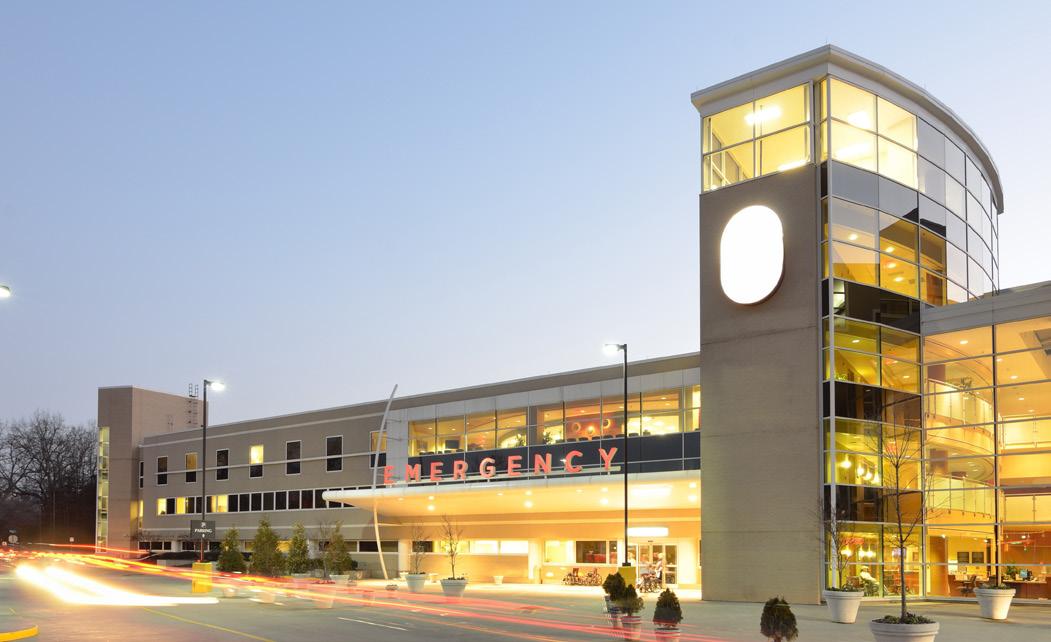
At DRP we create bespoke recovery strategies for all our clients, which helps them to deliver an educated recovery model designed specifically for the industry which they are working. We can provide recovery for clients on Commercial, Residential, Retail, Rail, Airport and NHS sites.
Our aim is to deliver an ethical approach to debt recovery to help our clients capture any unpaid parking charges whilst at the same time allowing the motorist an opportunity to discuss their case. Within our group our priority is our client’s data, when making any decisions on strategy, reporting or collecting on a case Compliance is our first thought. When GDPR was introduced we decided as a group to implement a GDPR team at both of our offices. Our GDPR teams implement compliant processes and practices at each office along with helping our clients with any GDPR questions which they may encounter along the way. L
FURTHER INFORMATION
www.debtrecoveryplus.co.uk
banning of clamping and towingwhich means that the only legal way to protect their land is to introduce a robust parking management system.
In terms of the two largest political parties, the Labour Party has a long standing pledge to remove parking fees altogether in England, following on from the abolishment of parking fees at most NHS hospitals in Scotland and Wales in 2008. The Conservatives meanwhile have more recently launched their car parking pledge to introduce free car parking at hospitals for the two million ‘blue badge’ disabled drivers and passengers, as well as frequent outpatients, gravely ill patients, visitors to relatives in hospital for extended periods, and staff on night shifts who cannot use public transport.
Speaking in terms of policy, the Parking (Code of Practice) Act came onto the statute books in March 2019. It’s an enabling Act that provides for the creation of a single Code of Practice regulating private parking firms, and provides for the creation of a single independent appeals service for challenging parking charges. Simon Jarvis says that the real change we are seeing is hospitals’ ability to fund the right approaches to parking. This is impacting their ability to invest in parking solutions which: are simple and stress free for all to use; are considered fair; are efficient to operate; effectively control demand and space occupation; offer very easy ways to apply concessions (which is even more important now); and avoid possible punitive fines wherever possible. This is echoed by Grahame Rose, our representative from CP Plus, who points to the British Parking Association’s Code of Practice, which has been in circulation for many years. Bringing this into legislation – it will be compiled by the British Standards Institute – will change the landscape for parking operators. He says that a single appeals service will also take away any confusion and anomalies that sometimes occur under the current two appeals services (the other is run by the International Parking Community). However, with the free parking for specific groups announcement fresh in the mind, there is no doubt that change over the next ten years may be more dynamic than the ten years just passed.
When people do not pay Debt Recovery Plus is the leading provider of debt recovery services for the private parking sector in the country, and knows better than most the need to ensure debts are paid and issues resolved as quickly, and with as little disruption to the hospital, as possible. Through close reporting, management and direct relationships between the company and the NHS, Stewart Clure says they can help to identify any issues that may occur and help to work out new ways to improve services. In most situations, whether that be a staff member who has a permit issue or a family member who is visiting a sick relative each day who simply can not afford their parking, it is important to ensure an amicable solution is reached - often helping the motorist to

understand the reason for issuing the charge and the consequences of not paying.
Dave Smith says that it is important to consider the outcome hospitals wish to achieve, stressing that a good working relationship between hospital, parking operators and debt recovery companies is crucial to ensure that parking enforcement is undertaken fairly and responsibly.
Furthermore, every effort should be made to reduce the number of parking charges notices that need to be issued, by ensuring the rules are clear, simple to understand, easy to comply with and, above all, fit for purpose. As Grahame Rose suggests, an appeals decision tree should also be agreed so that appeals are dealt with consistently and fairly.
How to help NHS staff It is clear that staff parking continues to be a difficult task, especially for NHS organisations. So, aside from the fair/unfair argument, how can the issue best be solved? Inevitably there will be peak demands and conflicting demands between the priorities of administrators, clinicians, consultants, and facilities teams to name a few. Just how do you determine the priorities? Dave Smith says that the overarching consideration for us all is climate change and the NHS has been vocal about the role it wants to play in helping to reduce emissions. He says that staff parking requires the same solutions as patient and visitor parking. For staff this means being part of a sustainable travel plan, establishing priorities when and where space is insufficient to meet demand and incentives to reduce the need to travel by car. It’s also sensible to consider working arrangements and shift patterns to determine optimum occupancy. The solution is not necessarily immediately agreeable. Simon Jarvis points to the very innovative work from some of WPS’ healthcare customers in increasing the price of staff parking, making investments in additional capacity and making offsite parking far more practical and financially attractive. On the other hand, GroupNexus argues that it is not sustainable, nor in many cases environmentally acceptable, to keep building spaces sufficient to satisfy the demand for staff parking. The real solution, as suggested by Grahame Rose, is to encourage staff to use other forms of transport, car sharing and park and ride. He does concede, however, that encouraging staff to use other ways of commuting needs to be compelling, perhaps including financial incentives, more flexible working practices and better public transport. Equally, Stewart Clure says that, instead of increasing prices to encourage other modes of transport, NHS staff should receive a discounted rate for parking, often with a designated area for staff only. Alternatively, some operators can subsidise discounts at local contract parking sites for staff in return for a long term contracts.
Ultimately, the BPA says that the answer lies in a good working relationship with the NHS trust working in partnership to deliver the outcome they would like to see. L
Torbay puts trust in WPS’ parking solutions
The issue of parking within hospitals is constantly in the news and evokes strong emotions from all sides of the debate. Finding the balance between meeting the cost of delivering a service with providing a customer experience that is sensitive to the environment is no easy task. Convincing employees that parking is not a right, but a privilege, is also a challenge
In the vanguard of industry thinking is Joanne Brimblecombe, the Sustainability and Site Services Lead within the Estates and Facilities Management Division of Torbay Hospital, part of the Torbay & South Devon NHS Foundation Trust. And supporting Joanne and her team in delivering their vision is parking technology specialists, WPS. Jo explains: “Parking should be fair for all not free for all, and we support concessionary parking on our trust site.”
Complex site The Torbay Hospital site, while not especially large, is still noticeably complex. The diverse nature of the portfolio required a mix of solutions to be delivered: for the larger car parks, and staff car parks, a Pay on Foot solution is preferred, with barrier controls; for the smaller car parks, typically with a capacity of 20 vehicles or less, Jo has opted for Pay and Display.
Jo says: “Department of Health guidance recommends that ‘NHS organisations should consider Pay-on-Exit systems’. This is considered best practice and will improve the patient and visitor experience. Our site does not lend itself to only being able to offer one solution due to car park sizes so an option of both Pay on Foot and Pay and Display has been adopted and WPS has been able to offer Pay-on-Exit and Pay and Display solutions.” Alongside managing a portfolio of approximately 650 visitor parking spaces, it also had to accommodate large volumes (up to 1,100 spaces) of staff parking. It had to achieve all of this while ensuring vital highways (i.e ‘the blue routes’) were kept clear, so that emergency vehicles would not be held up by vehicles queuing on the surrounding roads.
Customer experience Jo explains: “Parking is the first experience our patients and visitors have of our hospital. It needs to be as smooth, hassle-free and as comfortable as possible, and that means having reliable systems that are easy to use, and easy to configure to manage concessions and other specific requirements.” The staff parking experience is similarly important: “At Torbay, we provide staff parking, and staff have to pay. They can do so either on a monthly basis, or pay as you go, but in both cases they use their NHS smart card that acts as an ID badge, a payment card, and a card to operate the barrier.”
In terms of visitor concessions, Torbay has adopted an innovative approach that gives them total discretion and control. Thanks to the full TCP IP architecture of the WPS ParkAdvance systems installed, concessions can be easily accommodated. Jo explains: “We have three scanners at various reception desks connected over our local network and several hand-held USB devices in the wards simply connected to ward PC’s.”
Discretion and control This level of control helps to avoid one of the biggest challenges every hospital faces. On the one hand, revenues are important to meet the cost of managing the parking estate; on the other, a recently bereaved visitor or patient just diagnosed with a serious illness does not need the additional stress of a Penalty Charge Notice.
Unauthorised and unwanted parking also has to be managed, and abuses minimised. Torbay Hospital manages to achieve the balance it needs, thanks in no small way to the flexibility of the WPS technology.
Jo concedes: “WPS technology was not the cheapest solution but offers the right level of technology, reliability, and ease of use. Its Pay on Foot systems have undoubtedly helped us to maximise our parking revenues.”
In selecting a parking solution, and an equipment provider, Jo considered various options and suppliers. Among them was a system based on Automatic Number Plate Recognition (ANPR): “We did consider ANPR and there is a place for ANPR in hospital parking, perhaps in the future. But operators who install systems that rely on enforcement and PCNs for their revenues can sit very uncomfortably in a hospital scenario.” Another option considered, was one centred around chip coins: “We looked at chip coins but they are very expensive to replace and easily lost,” she says. “They also need to be hygienically cleaned to prevent the spread of infections.”
Jo is excited by what the future holds. She says: “The principal advantage of the WPS technology is that it is effectively future proof. That enables us to think freely and differently about what we want to achieve to enhance the customer experience, knowing that whatever we do, the WPS technology will enable us to do it.” L
FURTHER INFORMATION
Tel: 0845 094 1543 wpsparking

GroupNexus is committed to providing effective hospital car park management while remaining sensitive to patients and visitor’s needs
GroupNexus (formerly CP Plus & Ranger Services) provides complete hospital car park management solutions. With over 25 years’ experience, we have a deep knowledge of the healthcare industry, with an excellent track record in delivering high quality parking services to hospitals across the UK. We provide parking expertise with the sensitive approach that is needed at hospital parking locations, working with over 20 NHS trusts at over 40 hospital sites. Parking enforcement is needed to help manage the car parks and prevent abuse but not at the distress of patients or relatives. Therefore, we train our staff to encompass a range of skills suitable for working at our NHS hospital car parks, as well as providing security management and tailor-made CCTV and control centre systems. With the implementation of more advanced technology at our NHS sites, we can expect to see further enhanced security and safety for patients and visitors. We understand the importance of keeping vital roadways clear, so that emergency vehicles have immediate access when on call, and the need to be aware that users of the car parks may have an emergency or be in a distressed state. Our unrivalled experience brings sector wide knowledge that allows us to advise on concessions, staff permit parking, green transport schemes and more.
Our end-to-end services: GroupNexus offers an end-to-end service, from technology that allows you to track, monitor and gather data on car park usage, to setting the standard for the provision of management services.
GroupNexus handles installation of ANPR linked car park management systems, barriers, parking permit applications, paid for parking services including machine, cashless and online, concessions, vehicle alerting, user intelligence and on the ground facilities management, parking assistants,

enforcement, security and maintenance.
NexusInsights: NexusInsights has a complete range of insight services that can benefit your trust. We get under the skin of each of our client’s sites enabling us to build a bespoke package that provides real and valuable insights into how each facility is being used.
The aim of our parking services is to help hospital car parks function in a more logical manner, with patient and visitor needs taken into consideration, enabling the smooth running of vital services. L
FURTHER INFORMATION
www.groupnexus.co.uk info@groupnexus.co.uk
